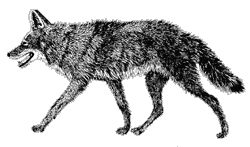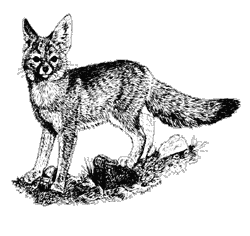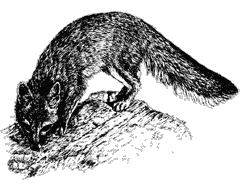Coyote & Fox
The coyote is without a doubt the most famous desert animal, the very symbol of the west. He is prominently figured as the Trickster as well as the Wise One in Native American myths and legends. The coyote fascinates us with its intelligence and adapability. It can survive eating anything from saguaro fruit to roadkills, and is able to live in any habitat from cactus forest to the city. The coyote has expanded its range throughout the United States despite human attempts to eradicate it. The coyote is not only intelligent, curious and playful, it has very keen senses that adapt it for survival — acute hearing, excellent vision, and an extremely sensitive sense of smell.

Coyote
The gray fox is the quieter relation, going about its nocturnal hunting without attracting as much attention as does the coyote. This fox doesn’t dig as much as coyotes do, but it is our only canid that regularly climbs trees. It hunts in and sometimes sleeps in trees, and has even been seen napping in the arms of a saguaro.
The little kit fox inhabits the dry, open flats and is more nocturnal, so it is not often seen by people. The kit fox is also more carnivorous than the coyote or gray fox, depending on kangaroo rats for most of its diet. This fox is a great digger, and any area occupied by kit foxes will be pocked with dozens of den holes.
© Pinau Merlin
Sonoran Desert species:
coyote (Canis latrans)
gray fox (Urocyon cinereoargenteus)
kit fox (Vulpes macrotis)
Order: Carnivora
Family: Canidae
Spanish names: coyote, zorro gris (gray fox), zorrito norteña (kit fox)
Distinguishing Features
Coyote: A coyote resembles a medium-sized dog with a long, bushy black-tipped tail, big ears, and a pointy face. The fur color varies from grayish to light brown, with a buffy or white underbelly. You’ll never see a fat coyote in the wild. Wiry and with long, slender legs and small feet, a desert coyote usually weighs only 15 to 25 pounds. The tracks are much smaller than those of a domestic dog of the same size.
Click here to hear coyote sounds
Gray fox: The gray fox can be distinguished from the coyote by its smaller size — it weighs in at around 5 to 9 pounds. The gray fox has a grayish coat with rufous-colored hairs on the ears, neck, legs, and underside. A black stripe runs along the top of its long, bushy, black-tipped tail.
Kit fox: This is the smallest of our foxes — really only the size of a house cat. It has a large, bushy black-tipped tail, and is otherwise buff-colored. The kit fox weighs about 4 or 5 pounds and stands about a foot tall at the shoulder. It has large ears and a very narrow, pointy muzzle.
Habitat
Coyotes are extremely adaptable and are found in all habitats, even in cities. Gray foxes prefer the rockier canyons where coyotes find it more difficult to hunt. Kit foxes inhabit the open, sparsely vegetated flats and areas with deeper soils for digging dens.
Feeding

Kit fox
Diet: All three of our canines are omnivores, eating anything from road-killed carrion to cactus fruit, mesquite beans, seeds, plants, and meat. They hunt small animals such as rodents, rabbits, birds, snakes, insects — especially grasshoppers and crickets — and any injured animal they can subdue.
Kit foxes prey mainly on kangaroo rats, but also supplement these with mice, rabbits, and a very little vegetable material.
Behavior: These canids scavenge for whatever they can find, sometimes running along the roads in the morning looking for roadkills. They also actively hunt small prey. They use their keen senses of smell and hearing to find occupied burrows they can dig into after mice or ground squirrels. In addition they chase down rabbits and pounce on grasshoppers.
Gray foxes and coyotes compete for similar prey, and so coyotes will often kill gray foxes when they can catch them. When coyote populations diminish due to mange, distemper or other factors, fox populations usually increase as a result.
Life History
Coyotes are mostly social animals, living in small family groups. Within the larger hunting area of a coyote family is a central core area where the den sites are located. This area is scent-marked and defended, particularly during the spring and summer months. Coyotes urinate on bushes or other plants, then scrape the ground with their paws, which have scent glands. This leaves both olfactory and visual markers for other coyotes. Scats are also used to mark the territory.
The breeding season is February to March with young born in April and May. Coyotes only use dens for whelping pups. They are very secretive about the den location and if it is disturbed by predators or people the mother coyote immediately moves the puppies to a safer site. Some yearling pups may stay with the parent coyotes through the next winter and help raise the new batch of puppies in the spring.
Coyotes typically sing a “good morning” wake up song around dusk as they prepare for the night’s hunt. They also sing to communicate with neighbors, to keep track of family members, after summer rains, during the full moon, and it seems, just for fun.
Gray foxes are the only canines able to climb trees (although a coyote sometimes manages to get part way up a tree with accommodating branches). They forage in trees, and can sometimes be seen sleeping up in cottonwoods or mesquites (safe from coyotes and other predators). Gray foxes breed in late winter; the pups are born in March or April. They often den in boulder piles, caves, and other natural cavities, or in mine shafts. Both parents feed the pups, but the father fox does not occupy the den with them. Instead he guards the den from a vantage point where he can watch for predators or other danger. The young foxes are able to hunt for themselves at around 4 months of age. Foxes often leave their scats in prominent places, such as on the tops of boulders, as territorial markers.

Gray fox
Kit Foxes can survive without free water, gaining what they need from the blood and moisture in their prey, and so can live in the most arid areas. They are the only canines to use dens year-round. Kit foxes are nocturnal — retreating to the relative coolness and humidity underground during the day probably helps them to survive in these hot, arid environments. Kit foxes change dens frequently, and there will be many mounds and holes in kit fox territory. Some dens may have as many as 7 to 10 entrance holes, making it appear that there are more kit foxes than there really are. These foxes are solitary during July through September, but females move into family dens in October to prepare for the new pups. The males join them later. The pups are born in February and March. Both parents feed them, bringing a steady diet of kangaroo rats for 5 or 6 months — then the young foxes are on their own. Signs of a den with pups include food remains, feathers, fur, and scat.
Kit fox numbers are declining due to loss of habitat and poisoning.
Turning the Tables
While hiking up an old mining road in the Tucson Mountains early one April morning I caught sight of an animal moving deliberately along the sandy floor of a canyon. It was a good distance away but I could make out a large, bushy tail. It was a gray fox. In another few seconds the fox disappeared behind a cliff wall. It didn’t appear to have seen me, so I decided to move up the trail and catch a better view as the fox came around the cliff. I walked on and then stood in one spot for what seemed like twenty minutes, though I suppose it was only about five. I didn’t want to move again for fear the fox would reappear and see me. Suddenly, to my surprise, I noticed movement only about 40 feet (12 m) away from me down the hill. It was the fox. While I’d been staring at the canyon floor, it had climbed the hillside below me. As I watched, the fox made its way to a large, flat rock, lay down, looked around contentedly — who wouldn't on such a gorgeous spring morning! — and began a slow, careful process of licking its legs and body. I watched for quite a while before quietly moving away, not wishing to startle the fox. So often, I realized, we are the ones watched in secret by the wildlife around us. To be in this position felt like an honor.
The Mexican Wolf
The Mexican wolf (Canis lupus spp. baileyi) was not a desert animal, but did inhabit the mountainous areas, woodlands, and riparian habitats of the region. The last howl of a wild Mexican wolf in Arizona was heard in the early 1970s. Despite a few unconfirmed sightings, the wolf was extirpated in Arizona; the only ones left alive were in zoos. Despite unconfirmed reports, no wild wolves have been proven to be alive in Mexico since the mid-1980s. In 1998 the U.S. Fish and Wildlife Service reintroduced the wolf into Arizona by releasing 13 captive-reared wolves into the Blue Mountains of eastern Arizona. The wolves proved very capable of surviving in the wild, successfully hunting elk, even after living their whole lives in captivity. Unfortunately, five of the wolves were shot, one was hit by a car, and one female disappeared and is presumed dead. As of this writing, others have survived and are doing well and avoiding people. Despite these setbacks, biologists feel confident that the wolf can make a comeback if the human predation stops. The Fish and Wildlife Service has increased monitoring of the wolves, stepped up law enforcement coverage to try to prevent further wolf shootings, and modified its educational programs (for example, teaching hunters how to recognize wolves).
We may again hear the howl of wolves and even find their tracks, but it will still be a rare treat indeed to actually see one of these elusive creatures in the wild.